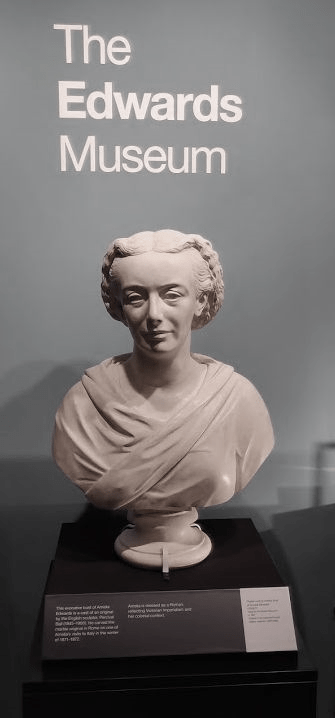Laser cleaning the Petrie Museum’s plaster cast bust of Amelia Edwards
By Lisa Randisi, on 15 April 2020
This week’s blog is written by Graeme McArthur, from our conservation team.
Our museum of Egyptology may be named after Flinders Petrie but it owes a large debt of gratitude to Amelia Edwards. She travelled to Egypt in 1873 for some winter sun and returned a dedicated campaigner for the preservation of Egyptian heritage. On her death in 1892 she left her own collection to UCL and left an endowment for a Chair in Egyptian Archaeology and Philology. The wording all but ensured that the job would go to Petrie. He also gave his collection to UCL in 1915 and the museum was born.
A bust of Amelia Edwards was sculpted by Percival Ball in around 1873 and is held by the National Portrait Gallery (NPG 929). A plaster copy was made for the Department of Egyptology at UCL by the British Museum in 1961 and thus ended up in the Petrie’s collection (LDUCE-UC80677).
At some point in the history of our bust it met with an unfortunate accident and there are splatters of grey paint across the right shoulder and around the right-hand side of the base. The bust has a layer of paint beneath this that is intended to make it look more like the marble of the original so it is important that this is preserved. Removing paint from a painted surface is extremely difficult by the usual methods of cleaning with solvents as they are likely to affect the underlying paint we want to preserve.
Last year UCL Culture acquired the Compact Phoenix laser cleaning system; this device has been designed specifically for use in the conservation of cultural heritage. Laser cleaning is most commonly used on stone as it was first developed for this around four decades ago, but has also been used successfully with plaster, terracotta, bone and ivory and even bronze. The most common use of a laser cleaner is stone that has been affected by pollution leaving behind a very dark crust. This is very common amongst collections that were held in cities such as London in the 19th and early 20th century. The Petrie Museum is no exception and LDUCE-UC62371 below is a good example.
Laser stands for Light Amplification by Stimulated Emission of Radiation and is essentially a very concentrated source of light. When the laser beam meets the surface of an object, part of the beam is absorbed and part is reflected. This tool is appropriate for use when the material we want to remove absorbs the laser radiation more strongly than the surface of the object beneath. This is generally the case with a dark layer of dirt on a white substrate, or in this case a layer of darker paint on a lighter paint. Another big advantage of this method is that there is no physical contact with the object so very fragile surfaces can be successfully cleaned.
As the dirt layer absorbs a lot of energy it causes a rapid rise in temperature which leads to a sudden expansion. This happens so quickly that it produces a force large enough to eject the dirt from the surface of the object. In the ideal laser cleaning scenario, the object’s surface will reflect most of the energy so the dirt can be removed without any danger of damaging the object. It is very obvious when material is being removed by the laser as it flashes and makes a loud clicking noise. Once an area has been cleaned the laser should no longer have this effect, if it does then the surface is being damaged.
Health and safety is very important in laser cleaning: goggles that absorb the wavelength of the laser are worn at all times to protect the eyes and the material being removed must be taken away by extraction as it has the potential to damage respiratory systems.
The strength of the laser differs depending on the distance you hold it from the surface, therefore it is best to start far away and slowly move in assessing the level of cleaning as you go. Once you reach a level of cleaning that you are happy with you can continue to clean at this distance. In this case the general dirt on the surface was removed very easily but the dark paint was barely affected so I had to move closer. At this point I could remove most of the spilled paint but the thickest drops of paint were left behind. Moving in closer appeared to be causing damage to the original paint layer so this wasn’t an option. I decided to try applying some water to the surface in these areas; this provides a little extra cleaning as the water instantly vapourises and pushes dirt away from the surface. This worked very well and I was able to successfully remove most of the paint drops.
It is important to remember that a laser cleaner is not a magic box that will be the best method of cleaning for every object. An important part of conservation is to assess an object, carry out tests and decide on the best method of treatment to produce the desired outcomes. However this is certainly an excellent new tool for us that will allow us to treat objects that would not have been previously possible.
 Close
Close






